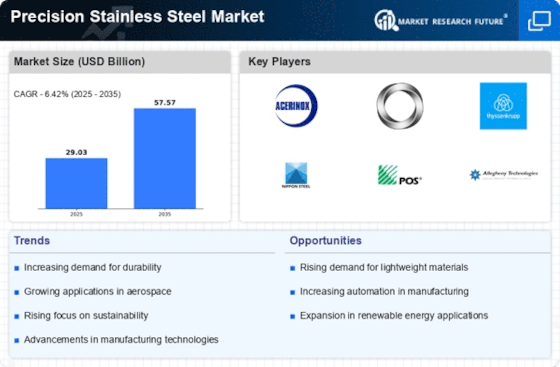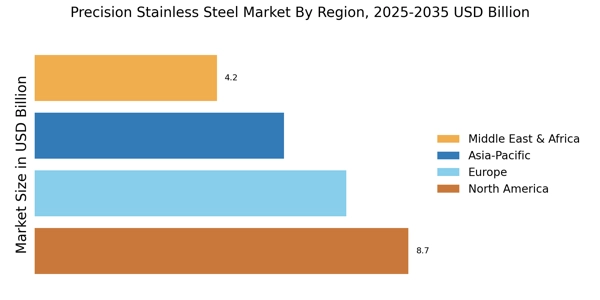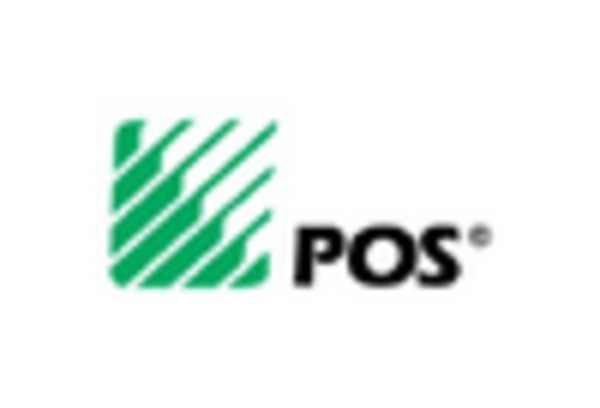Expansion of End-User Industries
The Precision Stainless Steel Market is benefiting from the expansion of various end-user industries, including aerospace, medical, and food processing. These sectors require high-quality materials that can withstand rigorous conditions and meet stringent regulatory standards. In 2025, the aerospace industry is projected to contribute approximately 18% to the overall demand for precision stainless steel, driven by the need for lightweight and durable components. Similarly, the medical sector's growth, fueled by advancements in healthcare technology, is expected to increase the demand for precision stainless steel in surgical instruments and implants. The food processing industry also plays a vital role, as precision stainless steel is essential for maintaining hygiene and preventing contamination. Thus, the expansion of these end-user industries is a significant driver for the Precision Stainless Steel Market.
Growth in Construction Activities
The Precision Stainless Steel Market is significantly influenced by the growth in construction activities across various regions. As urbanization accelerates, the demand for durable and aesthetically pleasing materials in construction projects is on the rise. Precision stainless steel is favored for its longevity and low maintenance requirements, making it an ideal choice for architectural applications. In 2025, the construction sector is expected to represent around 30% of the overall market share for precision stainless steel. This growth is further fueled by the increasing adoption of sustainable building practices, where precision stainless steel is utilized for its recyclability and energy efficiency. Consequently, the construction industry's expansion is a critical driver for the Precision Stainless Steel Market, as it seeks to meet the evolving needs of modern infrastructure.
Increasing Focus on Sustainability
The Precision Stainless Steel Market is witnessing an increasing focus on sustainability, which is becoming a key driver of market growth. As industries strive to reduce their carbon footprint, precision stainless steel is recognized for its recyclability and low environmental impact during production. In 2025, it is estimated that the demand for sustainable materials will account for approximately 20% of the total market for precision stainless steel. This shift is particularly evident in sectors such as construction and automotive, where companies are actively seeking eco-friendly alternatives. Furthermore, regulatory pressures and consumer preferences are pushing manufacturers to adopt sustainable practices, thereby enhancing the appeal of precision stainless steel. Consequently, the emphasis on sustainability is likely to significantly influence the trajectory of the Precision Stainless Steel Market.
Rising Demand in Automotive Sector
The Precision Stainless Steel Market is experiencing a notable surge in demand from the automotive sector. As manufacturers increasingly prioritize lightweight materials to enhance fuel efficiency, precision stainless steel emerges as a preferred choice due to its strength and corrosion resistance. In 2025, the automotive industry is projected to account for approximately 25% of the total demand for precision stainless steel. This trend is driven by the need for high-performance components that can withstand extreme conditions while maintaining structural integrity. Furthermore, the shift towards electric vehicles is likely to further bolster the demand for precision stainless steel, as these vehicles require advanced materials for battery casings and structural components. Thus, the automotive sector plays a pivotal role in shaping the dynamics of the Precision Stainless Steel Market.
Technological Innovations in Manufacturing
Technological innovations in manufacturing processes are reshaping the Precision Stainless Steel Market. Advancements such as additive manufacturing and precision machining are enhancing the production capabilities of precision stainless steel components. These technologies allow for the creation of complex geometries and improved material properties, which are essential for high-performance applications in various sectors, including aerospace and medical devices. In 2025, it is anticipated that the adoption of these advanced manufacturing techniques will lead to a 15% increase in the production efficiency of precision stainless steel. This improvement not only reduces production costs but also enables manufacturers to meet the growing demand for customized solutions. As a result, technological innovations are likely to play a crucial role in driving the growth of the Precision Stainless Steel Market.


















Leave a Comment